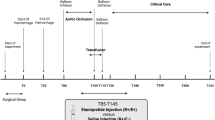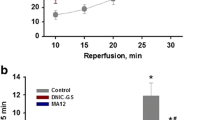Summary
The effect of recombinant human superoxide dismutase (rh-SOD) on infarct size was investigated in porcine hearts. The left anterior descending coronary artery was occluded in each of 24 anesthetized pigs for 45 min and reperfused for 24 h. The animals were randomly assigned to either rh-SOD (n=12) or placebo treatment (n=12). 2 min before reperfusion, an intracoronary (i.c.) infusion of rh-SOD (total dose: 2000 U/kg) or placebo was started which lasted for up to 45 min reperfusion. At the end of the experiment, the infarcted myocardium was assessed using a tetrazolium stain (NBT) and related to the risk region which was determined with a fluorescent dye. Two pigs of the SOD group and one of the control group died before the end of the experiments. Except for a lower calculated myocardial oxygen consumption and a lower dp/dtmax in the SOD group during ischemia, hemodynamic parameters of the two groups did not differ significantly. rh-SOD i.c. treatment during reperfusion did not reduce infarct size significantly. Infarct size amounted to 74±13% in the control group and to 66±19% in the treated group. The incidence of reperfusion arrhythmias was not affected by rh-SOD treatment. It is concluded that i.c. rh-SOD treatment at the beginning of reperfusion neither significantly reduces infarct size nor diminishes the incidence of reperfusion arrhythmias in this preparation.
Similar content being viewed by others
References
Ambrosio G, Becker LC, Hutchins GM, Weisman HF, Weisfeldt ML (1986) Reduction in experimental infarct size by recombinant human superoxide dismutase: insights into the pathophysiology of reperfusion injury. Circulation 74:1424–1433
Boveris A (1977) Mitochondrial production of superoxide radical and hydrogen peroxide. Adv Exp Med Biol 78:67–82
Brawn K, Fridovich I (1981) DNA strand scission by enzymatically generated oxygen radicals. Arch Biochem Biophys 206:414–419
Bretschneider HJ, Hellige G (1976) Pathophysiologie der Ventrikelkontraktion-Kontraktilität, Inotropie, Suffizienzgrad und Arbeitsökonomie des Herzens. Verh Dtsch Ges Kreislaufforsch 41:14–30
Burton KP, McCord JM, Ghai G (1984) Myocardial alterations due to free-radical generation. Am J Physiol 246:H776-H783
Del Maestro RF (1980) An approach to free radicals in medicine and biology. Acta Physiol Scand Suppl 492:153–168
Eckstein RW (1954) Coronary interarterial anastomoses in young pigs and mongrel dogs. Circ Res 2:460–465
Fantone JC, Ward PA (1982) Role of oxygen-derived free radicals and metabolites in leukocytedependent inflammatory reactions. Am J Pathol 107:397–418
Frank L, Massaro D (1980) Oxygen toxicity. Am J Med 69:117–126
Freeman BA, Crapo JD (1982) Biology of disease: Free radicals and tissue injury. Lab Invest 47:412–426
Gallagher KP, Buda AJ, Pace D, Gerren RA, Schlafer M (1986) Failure of superoxide dismutase and catalase to alter size of infarction in conscious dogs after 3 hours of occlusion followed by reperfusion. Circulation 73:1065–1076
Geary GG, Smith GT, McNamara JJ (1982) Quantitative effect of early coronary artery reperfusion in baboons. Circulation 66:391–396
Hammond B, Hess ML (1985) The oxygen free radical system: Potential mediator of myocardial injury. J Am Coll Cardiol 6:215–220
The ISAM Study Group (1986) A prospective trial of intravenous, streptokinase in acute myocardial infarction (ISAM): Mortality, morbidity and infarct size at 21 days. N Engl J Med 314:1464–1471
Jolly SR, Kane WJ, Bailie MB, Abrams GD, Lucchesi BR (1984) Canine myocardial reperfusion injury. Its reduction by the combined administration of superoxide dismutase and catalase. Circ Res 54:277–285
Klein HH, Nebendahl K, Lindert S, Kreuzer H (1986) A modified regionally ischemic porcine heart preparation with eligible residual blood flows. Basic Res Cardiol 81:384–393
Klein HH, Pich S, Lindert S, Nebendahl K, Kreuzer H. Ischemic cell death in reperfused porcine hearts: A histochemical and functional study. J Mol Cell Cardiol 18, Suppl 1, Abstract 381, submitted for publication
Klein HH, Puschmann S, Schaper J, Schaper W (1981) The mechanism of the tetrazolium reaction identifying experimental myocardial infarction. Virchows Arch (Pathol Anat) 393:287–297
Klein HH, Schubothe M, Nebendahl K, Kreuzer H (1984) Temporal and spatial development of infarcts in porcine hearts. Basic Res Cardiol 79:440–447
Kontos HA (1985) Oxygen radicals in cerebral vascular injury. Circ Res 57:508–516
Manning AS, Coltart DJ, Hearse DJ (1984) Ischemia and reperfusion-induced arrhythmias in the rat. Effects of xanthine oxidase inhibition with allopurinol. Circ Res 55:545–548
McCord JM (1985) Oxygen-derived free radicals in postischemic tissue injury. N Engl J Med 312:159–163
Meerson FZ, Kapan VE, Kozlov YP, Belkina LM, Arkipenko YV (1982) The role of lipid peroxidation in the pathogenesis of ischemic damage and the antioxidant protection of the heart. Basic Res Cardiol 77:465–485
Mitsos SE, Askew TE, Fantone JC, Kunkel SL, Abrams GD, Schork A, Lucchesi BR (1986) Protective effects of N-2 mercaptopropinyl glycine agains myocardial reperfusion injury after neutrophil depletion in the dog: evidence for the role of intracellular-derived free radicals. Circulation 73:1077–1086
Nachlas MU, Shnitka TK (1963) Macroscopic identification of early myocardial infarcts by alteration in dehydrogenase activity. Am J Pathol 42:379–405
Schaper W, Frenzel H, Hort W (1979) Experimental coronary artery occlusion. I. Measurement of infarct size. Basic Res Cardiol 74:46–53
Schaper W, Frenzel H, Hort W, Winkler B (1979) Experimental coronary artery occlusion. II. Spatial and temporal evolution of infarcts in dog hearts. Basic Res Cardiol 74:233–239
Simoons ML, Serruys PW, v d Brand M, Bär F, de Zwaan C, Res J, Verheugt FWA, Kraun XH, Remme WJ, Vermeer F (1985) Improved survival after early thrombolysis in acute myocardial infarction. Lancet 2:578–582
Sjöquist P-O, Duker G, Almgren O (1984) Distribution of the collateral blood flow at the lateral border of the ischemic myocardium after acute coronary occlusion in the pig and the dog. Basic, Res Cardiol 79:164–175
Uraizee A, Reimer KA, Murry C, Jennings RB (1987) Failure of superoxide dismutase to limit size of myocardial infarction after 40 minutes of ischemia and 4 days of reperfusion in dogs. Circulation 75:1237–1248
Werns SW, Shea MJ, Driscoll EM, Cohen C, Abrams GD, Pitt B, Lucchesi (1985) The independent effects of oxygen radical scavengers on canine infarct size. Reduction by superoxide dismutase but not catalase.
Werns SW, Shea MJ, Lucchesi BR (1986) Free radicals and myocardial injury: pharmacologic implications. Circulation 74:1–5
White FC, Bloor CM (1981) Coronary collateral circulation in the pig: correlation of collateral flow with coronary bed size. basic Res Cardiol 76:189–196
Woodward B, Zakaria MMNM (1985) Effect of some free radical scavengers on reperfusion induced arrhythmias in the isolated rat heart. J Mol Cell Cardiol 17:485–493
Author information
Authors and Affiliations
Additional information
This study was supported by a grant from Deutsche Forschungsgemeinschaft, SFB-330 Organprotektion Göttingen, F.R.G.
This paper includes parts of the “Habilitationsschrift” of Dr. H. H. Klein
Rights and permissions
About this article
Cite this article
Klein, H.H., Pich, S., Lindert, S. et al. Intracoronary superoxide dismutase for the treatment of “reperfusion injury” A blind randomized placebo-controlled trial in ischemic, reperfused porcine hearts. Basic Res Cardiol 83, 141–148 (1988). https://doi.org/10.1007/BF01907268
Received:
Issue Date:
DOI: https://doi.org/10.1007/BF01907268




